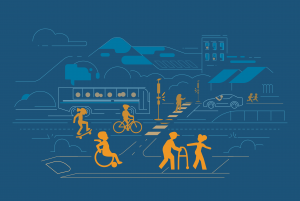Sweden continues positive Vision Zero trend in 2017
253 Swedish crash deaths in 2017 – lowest number in modern times
New statistics from the Swedish Transport Administration show that measures taken to reduce deaths in traffic are working.
(DCR Design based on a newly released report from Trafikverket)
According to the Swedish Transport Administration (Trafikverket) the main reasons for the continued drop in traffic deaths are reduced speed limits better adapted to existing road designs, safer cars and, in urban areas, separating and protecting pedestrians and cyclists from auto traffic.
Targets and efforts towards Vision Zero (no deaths or major injuries in traffic) in Sweden have consistently aligned to reduce the number of crash deaths, the number now less than half of what it was 20 years ago (550 deaths in 1998).
Sweden now has a traffic death rate of 2.5 per 100,000, which is the 3rd lowest in the world, just after Norway and Switzerland.
The Swedish Parliament decided at that time to institute Vision Zero as a road safety policy goal, based on slower auto speeds, better road designs and separating pedestrians and cyclists from cars. The current goal of reducing the number of deaths in traffic to 220 by 2020 looks to be achievable, but there are still significant obstacles to reaching this.
Many drive too fast
While the trend indicated by the 2017 statistics is welcome, the Swedish Road Administration is not optimistic that the goal of no deaths in traffic can be reached. Among several reasons why this this will be difficult is that few drivers follow posted speed limits.
Other reasons Vision Zero may be elusive include: the number of drivers driving under the influence (although very low in Sweden) is increasing, few cyclists use helmets and building safer roads through improved design is going very slowly.
Prioritized efforts in Sweden to reach the 2020 goals, continuing the trend towards Vision Zero include: increased road checks for drivers under the influence of alcohol and drugs, improved safety for pedestrians and cyclists including protection and separation from car traffic, increased use of bike helmets and use of new technology (e.g. geofencing) to enforce vehicle restrictions and slow car speeds in dense urban areas.
International comparisons
Sweden now has a traffic death rate of 2.5 per 100,000, which is the 3rd lowest in the world, just after Norway and Switzerland. The average for the European Union countries is 5.1 deaths per 100,000. The US lags far behind many countries, with a rate of 11.6 deaths per 100,000 and total numbers and rates that are increasing, despite rhetoric that action is being taken.

Want to work with us? Feeling inspired?
Contact us at info@dcrdesign.net or checkout our social medias: LinkedIn, X and Instagram
For more information visit:
Vision Zero, Safe systems approach, NHTSA and FHWA




